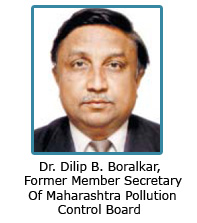DNA News Paper Mumbai 2.12.09 :
Common Effluent Treatment Plants for Industrial Clusters

The scenario in Maharashtra in the 1990s was very bad in terms of industrial water pollution. The situation was compounded further due to insufficient cooperation among industries to set up CETP By year 2000, most industrial clusters had set up CETPs mainly due to the efforts by Maharashtra Industrial Development Corporation (MIDC) and Maharashtra Pollution Control Board (MPCB). However, barring one or two. almost all the CETPs did not comply with the standards. By year 2003, the total volume discharged by the CETPs in Maharashtra had reached to the tune of 225 MLD (million liters per day). In terms of pollution parameter of COD it is equivalent of 10.000 tons per day as against permissible limit of one ton. MPCB armed with court orders, mobilized public support and initiated concerted actions against the CETPs.
Technical up gradation of CETPs was undertaken and recalcitrant effluents were segregated and treated. Local area environment committees, citizens groups, were set up by MPCB. Efforts of regulators to support the CETP agency and involve local people in environmental management created confidence in the minds of people as positive results were on field In form of increased compliance and reduced pollution in the area. This innovative approach was appreciated by the Supreme Court Monitoring Committee and the example followed by other States.
It has taken almost two decades of consistent efforts by MIDC and MPCB to institutionalize the CETP system as a common infrastructure for environment protection in industrial areas. However, it is seen that the CETPs are not being managed properly and not meeting performance standards. The situation had become so alarming that Central Pollution Control Board had to intervene in 2007-08 and issue directions to the MPCB that new units shall not be allowed or existing units shall not be permitted expansion etc. In the industrial areas where CETPs are not meeting the norms. To consolidate the gains achieved and to address the present scenario, existing CETPs must be up graded and additional CETPs constructed within a time frame. Treated waste water should be reused or recycled in such a manner that our Industrial estates become zero liquid discharging in next five years.
---o0o---
